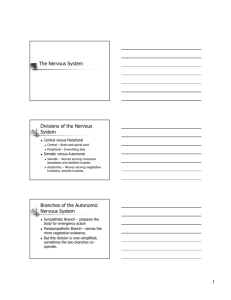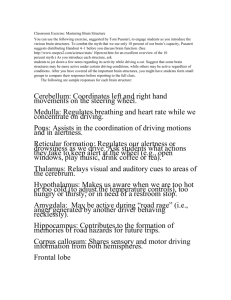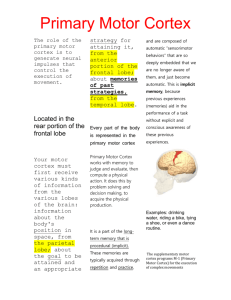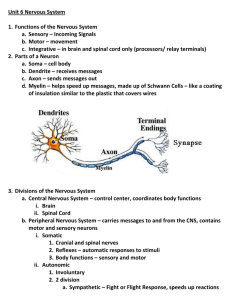CNS
advertisement
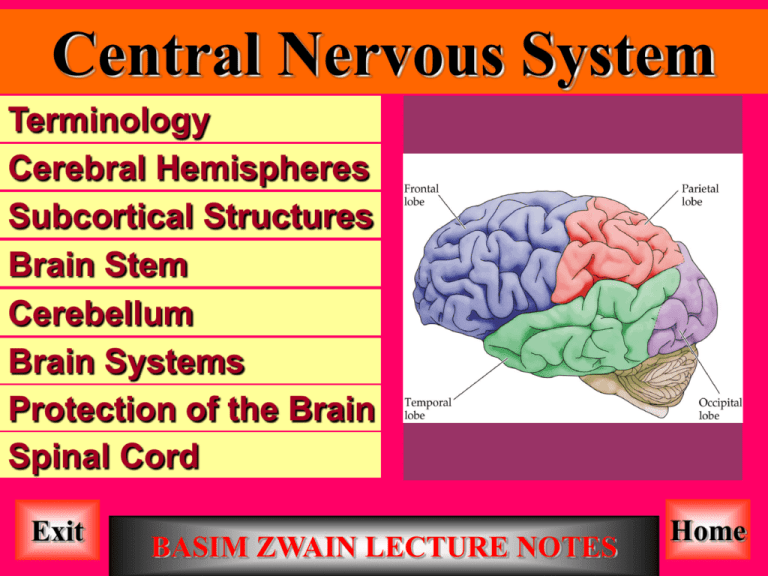
Central Nervous System Terminology Cerebral Hemispheres Subcortical Structures Brain Stem Cerebellum Brain Systems Protection of the Brain Spinal Cord Exit BASIM ZWAIN LECTURE NOTES Home Terminology Anatomical References Anatomical structures can be sectioned along flat surfaces (planes) Note: The nervous system is organized along an anterior Anatomical structures can be divided into a. Coronal (frontal) Anatomical structures can be divided into sides Relative position of anatomical structures to posterior axis with acan fluidbe filled tubeinto running through Anatomical structures divided top and bottom Longitudinal axis andplane back Exit Home structure i.front Vertical a. Midline a. Ipsilateral the center. At thedividing anterior end, the into structure have a. Superior a. Nervous system is organized along an anterior Front anterior/posterior parts b. Medial i.i. Structures localized the same side and to enlarged with evolutionary advancement Dorsal (Posterior fortobipeds) to posterior axis i.Contralateral Anterior b. i.Sagittal Close to thefor midline b. accommodate this enlargement, the brain has b. Inferior b. Different regions of the brain have different ii. Rostral i. Vertical plane dividing structure into c. Lateral i.i. Structures localized to different sides become distorted and curved so that some structures are Ventral (Anterior for bipeds) longitudinal axis b. Back right and left halves i.Proximal Away from theassign midline c. more difficult to anatomical references. i.Midsaggital Cerebellum is ventral to the forebrain axis but Posterior ii. (median) i. Close to a fixed reference point dorsal to that of the brain stem ii. Caudal iii. Parasagittal d. Distal c.i.Horizontal Distant to(transverse) a fixed reference point i. Divides structure into superior and inferior Exit BASIM ZWAIN LECTURE NOTES Home Terminology Nervous system terminology Terms Important referring sulci to and axons gyri Terms to neuron cell bodies found in CNS Neural referring cell bodies are often organized in rows a. Grey (projection) matter Tract a. Lamina Nerve Terms Sylvian that refer(lateral) to the external morphology of the fissure i. Generic term of forcell neurons inseparated the CNS from another Bundle i.brain Rowreferring or layer bodies Terms to neuron cell bodies found in PNS i. Refers to CNS Cingulate sulcus i. Refers to PNS i.Parieto-occipital Separates temporal and White Central matter sulcus b. Nucleus sulcus row or layer by a layer of axons or dendrites a. Surface convolutions a. Ganglion Precentral gyrus Calcarine sulcus i. Collection of axons that run together Insula i. Clearly defined mass of neuron cell bodies i. Medial surface of the frontal frontal lobes ii. Parallel structural surface i.to Extends from superior toof Commissure ii. Set of axons, also known as fibers, i. Separates frontal (anterior) i.Collection Gyrus: ridge on the surface of the cerebrum (and of neurons in the PNS ii. Bundle of axons either projecting i. Generic term for a collection axons i. Medial surface of the i.Substantia Commonly known the motor cortex c. i.not Fold created byas the temporal but do necessarily share the same and parietal lobes b.cerebellum) Column ii. Temporal is inferior to the inferior surface i.from Any collection of axons that connect that project from one structure andor and parietal lobes (posterior) the CNS to a muscle or gland i. Less distinct borders than nuclei occipital lobe i.origin Row oflobe cells perpendicular the surface of the brain ii. Inferior to thistoto sulcus is the or destination ii. Sulcus: groove frontal and extends the ii. Divides parietal from one side of the organ brain with the other side form synapses on a second common d. Locus a ii. sense Defines the location to the CNS of the ii.from Share a common function ii. Commonly referred to as the iii. Fissure: a deep grooveoccipital lobe limbic lobe caudally located occipital lobes i. structure Small but well defined visual cortex mass of neuron cell bodies operculum iii. Parietal lobe is superior to lateral fissure Exit BASIM ZWAIN LECTURE NOTES Home Terminology Organization of the nervous system Organization of gray and white matter a.Functionally CNS organized into two divisions i. Gray matter is organized on the surface of a. Central nervous system (CNS) thei. brain lamina Brainin(Cerebellum, cerebrum and ii. White matter is organized centrally brain stem) iii. White matter constitutes the majority of ii. Spinal cord brain mass Peripheral nervous system (PNS) b.b.PNS Somatic i.i.Gray matter is centrally located ii.ii.White matter is organized on the surface Autonomic Exit BASIM ZWAIN LECTURE NOTES Home Cerebral Hemispheres General characteristics Lobes Organized into functional areas a. Motor Contralateral control the body i.Functions Voluntaryare control ofofmovement lateralized Function arises from is concerted activity a.a.Sensory Each concerned b. Eachhemisphere hemisphere has unique with the opposite of the body i.functions Conscious awareness of sensation c. Association i. Integration ii. Emergent properties Exit BASIM ZWAIN LECTURE NOTES Home Cerebral Hemispheres Motor areas Primary motor cortex (Brodmann 4) Cortical involved in movement a. Located in the areas precentral gyrus of frontal lobe b. Conscious control of cortex motor execution a. Primary motor cortex Broca’s Premotor area (Brodmann (Brodmann 44/45) 6) Frontal eye field 8)throat and c. Pyramidal cells give rise to corticospinal tracts a. a. muscles Learned motor of(Brodmann thethe tongue, skills lips b.Directs Premotor cortex a. Voluntary movement of related the eyes d. Somatotopy b. Motor planning i. Patterned for or speech repetitious activity c. Broca’s area i. Body is mapped (motor homunculus) ii. Representation is proportionate to level of motor control d. Frontal eye field iii. Innervation is primarily contralateral Exit BASIM ZWAIN LECTURE NOTES Home Cerebral Hemispheres Sensory areas Cortical areas involved in processing sensation Visual Auditory areas Body isareas mapped Primary somatosensory cortex (Brodmann 1, 2 & 3) (somatosensory a. homunculus) Parietal lobe a. Primary visual cortex (Brodmann 17) 18 b. Visual association areas (Brodmann i. Postcentral gyrus a.i.Primary auditory cortices (Brodmann Somatosensory association area (Brodmann 5 & 7) Occipital lobe & 19) Gustatory cortex (Brodmann 43) b. Auditory association area (Brodmann 42 & 43) Olfactory cortex Representation is b. Somatici.ii.41) senses Located primarily insensory calcarine Interpretation of visual stimuli a. Parietal lobe deep to the temporal lobe Recognition of stimuli as specific auditory a. proportionate Integrate various somatic inputs a. i.Medial aspects of temporal lobe i.ii.Superior margin of temporal lobe i. Pain experiences and temperature sulcus Past visual experiences (e.g., speech) i. Piriform lobe (uncus) to number of sensory ii. Pitch, rhythm and loudness ii.receptors Touch iii. and proprioception Sensory function with largest cortical representation c. Somatotopy Innervation is primarily contralateral Innervation iv. is primarily contralateral Exit BASIM ZWAIN LECTURE NOTES Home Cerebral Hemispheres Association areas Language areas a. Bilaterally located b. Wernicke’s area Association areas (in addition to i. Posterior temporal lobe on11 left side General Prefrontal interpretation cortex (Brodmann area &these 47) discussed before) Characteristics a. cortex Sounding out unfamiliar words a.Encompasses a.ii.Prefrontal Anterior portion parts of of frontal temporal, lobe parietal and occipital lobes a. Analyze, recognize andbehavior act on sensory in puts Gnostic area i. b. Generally b. Intelligence, found complex on the left learned side and personality c. Affective language areas b. Multiple inputs and outputs b. Storage c.i.Language Understanding of complex written sensory and memories spokeand language c. areas Located contralateral to Broca’s Wernicke’s areas ii. Nonverbal and emotional components of language ii. Sounding out unfamiliar words Exit BASIM ZWAIN LECTURE NOTES Home Cerebral Hemispheres Organization of the cortex Neocortical layers a. Layer I i. Few cells; primarily axons, dendrites and synapses Common features b. Layers II & III a. Cell bodies are arranged in sheets (layers) Cytoarchitecture i. Pyramidal cells that project to and receive projections i.Lamina Parallel surface of brain froma.other corticaltoregions b. Layer I of lacks bodies c. Layer IV i. Layers cellscell parallel to brain surface i. Stellate cells that layer receive most of thalamic input and Molecular b. i.Columns project locally to one otherlayer lamina c. At least has pyramidal cells i. Row of cells perpendicular to brain surface d. Layer V & VI i. Share Emit large apical function dendrites ii. a common i. Pyramidal neurons that project to subcortical regions ii. Extend up to layer I such as the thalamus, brainstem, and spinal cord, and other cortical areas Exit BASIM ZWAIN LECTURE NOTES Home Subcortical structures Basal nuclei (ganglia) Structures Function Organization a. Caudate a. Motor control a. Receive inputs from most cortical structures i. Starting, stopping and monitoring movement b. Putamen b. Project to motor cortex via the thalamus ii. Inhibit unnecessary movement c. Globus pallidus Exit BASIM ZWAIN LECTURE NOTES Home Subcortical structures Diencephalon Thalamus Hypothalamus Epithalamus Organization c. control center nuclei of the body a. Visceral Comprised of multiple a.i.Core ofnucleus forebrain Autonomic control (e.g.,specific BP, HR) Each receives a. Pineal body i. Surrounded by cerebral hemispheres a. Location ii. Emotional response (fear, sex drive) afferent projections i. Control of sleep-cycle b. Three bilateral structures b.i. Connected Between optic to the chiasm pituitary and iii. Regulation of body temperature ii. Nuclei interconnect ii.i.Melatonin Thalamus mammillary i. Via infundibulum bodies iv. Regulation of feeding iii. Nuclei project (relay) processed b. ii. Choroid plexus Hypothalamus ii. Below thalamus v. Regulation of thirst spinal information to particular cortical areas i.iii. Production of cerebral fluid (CSF) Epithalamus Regulation of circadian rhythm b.vi. Process and relay information vii. Control of endocrine function Exit BASIM ZWAIN LECTURE NOTES Home Brain Stem Structures 1. Lies between pons and spinal cord Midbrain Pons Medulla oblongata 1.4.Lies between midbrain andfunction medulla Control of visceral motor a.a.Cerebral No obvious peduncles demarcation between 2.a.Comprised mostly of conducting fibers Cardiovascular center medulla i. Fiber tracts and spinal connecting cord cerebrum with a. i.Connection between higher brain areas Cardiac center inferior 2. Landmarks structures and spinal cord center ii. Vasomotor b. a.Corpora Pyramids quadrigemina i. Longitudinal projections Organization Functions b. Respiratory center i.i.Superior Descending and corticospinal inferior colliculi tracts b. i.Pontine nuclei Functional 1. Autonomic areas behavior Control rate and depth of breathing c. ii. Substantia Decussate nigra i. Relay information between a. 2. Midbrain Pathway for fiber motor c. Reflex 3. i. Color Nucleiisfor due several to melanin cranial (DA nerves precursor) cortex and b. cerebellum tracts Pons i. Vomit a. ii. Hypoglossal Nucleus of DA (XII) neurons 3. ii. Nuclei forMedulla severalnerves cranial nerves c. 3. Cranial oblongata Hiccup d. b.Red Glossopharyngeal nucleus (IX) a. iii. Trigeminal (V) Swallowing c. i. Motor Vagusreflex (X) b. iv. Abducens (VI) Coughing e.d.Reticular Accessory formation (XI) c. v. Facial (VII) Home Exit Sneezing e. i. Some Vestibulocochlear of the RF nuclei (VIII) are found here BASIM ZWAIN LECTURE NOTES Cerebellum Function Anatomy 2. Structure a. Bilateral b. Consists of cerebellar hemispheres i. Connected by vermis 1. Location c. Hemispheres consists of lobes i. Posterior Dorsal to ponscontraction and medulla Precisea.timing of skeletal ii. Anterior b. Caudal to occipital lobe a. Sensory and motor information is integrated iii. Flocolonodular d. Gray and white matter is organized like cerebrum i. Gray outside/white inside e. Cerebellum is connected via cerebellar peduncles i. Fiber tracts connecting brain stem and sensory cortices with cerebellum Home Exit BASIM ZWAIN LECTURE NOTES Brain Systems 2. Structures Reticular Limbic system formation a. Upper part of brainstem b. Complex Rhinencephalon 1. of nuclei and white matter Septal nuclei a.i.Disperse and widespread connectivity Cingulate gyrus 2.ii.Location Group of cortical structures iii. Parahippocampal gyruspons and midbrain a.1. Central core of medulla, Located on medial aspect of the cerebral iv.Function Hippocampus 3.a. 3. Function and diencephalon c.hemisphere Amygdala a. Maintain wakefulness attention a. Emotional and and affective state Connectivity is complex d.b. structures i. Diencephalon Coordination of all afferent sensory i. Hypothalamus information Anterior nucleus of the activity thalamus b.ii.Coordination of muscle e.i.Fiber tracts of efferent motor information Modulation i. Fornix ii. Fimbria Home Exit BASIM ZWAIN LECTURE NOTES Protection of the Brain Blood-brain Primary Meninges Cerebrospinal mechanism barrier fluid (CSF) Brain environment is tightly controlled Anatomy of the ventricular system a. Most bloodborne substances cannot readily 3. Arachnoid enter the brain 2.1. Dura Bone Function e. Dural septa a. Four fluid-filled chambers a. Loose cover over brain d. Third is connected with fourth Mechanism a. Two fused layers a. Brain is encased in a bony skullcap Flow a. Form a liquid cushion for i.Does Falx i. Paired cerebri lateral d.i.Arachnoid villi not enter sulci 1. via Structure cerebral aqueduct a. Capillary endothelium is joined by tight i.2. Periosteal layer Membranes a. Produced in ventricles CNS organs ii. Falx ii. Third cerebelli i. Small Act like valves b. space between dura and arachnoid a. Three connective tissue membranes Choroid plexuses 4. Pia e. Fourth is continuous with junctions ii. Meningeal layer a. Meninges Found in ventricles and b. Provides nutrients iii. Tentorium iii. Fourth ii. Projection of archoid through dura into b. Exit 4th ventricle i.i. Subdural space i. Dura mater (tough mother) central a. Clings canal tightly to brain a. Produce CSF Relatively impermeable b. Periosteal layer is attached to the skull 3. Fluid c. CSF composition is f. Dural sinuses b. Chambers are continuous with dural sinuses central canal of spinal cord c. Bath brain c. Subarchnoid space ii. Arachnoid mater (spider mother) layer f. b. Fourth Invested has with openings blood to vessels b. Located in ventricles Barrier is selective i.a. Spinal cord does not have a periosteal Cerebrospinal fluid monitored i. Spaces each other between and dural with the layers central iii. Permits CSF to be absorbed into venous i. Deep to arachnoid iii. Pia mater (gentle mother) d. Absorbed into venous subarachnoid space a. Facilitated diffusion ofcord particular substances c. layer covers brain and spinal cord b.Meningeal Blood-brain barrier i. Control of autonomic ii. Collect canal of venous the spinal blood flow from brain blood ii. Filled with CSF i. Lateral apertures blood through arachnoid villi i. Glucose and others d. Dura projects inward to help anchor the brain functions iii. Directs blood flow back to jugular veins c. Interventricular foramen iii. Secured to pia by weblike extensions of ii. Median aperture b. Cannot prevent fat-soluble molecules from connect lateral with third the arachnoid diffuses into brain Home Exit BASIM ZWAIN LECTURE NOTES Spinal Cord Gross anatomy Cross-sectional Spinal pathwaysanatomy Meninges Descending (motor) pathways Gray matter and spinal roots a. Single layer Protected Dorsal root ganglion Characteristics a. Gray is a. organized like a butterfly Attachments a. Upper motor neurons i. Spinal dural sheath Bone Lateral Ascending horn (sensory) pathways a.Most Cell bodies of sensory neurons d.i.Indirect (tracts)—multi-neuronal Meninges Spinal nerves a. pathways decussate Bridge—gray commissure a. Denticulate ligaments b. Epidural space i.(fasciculi Vertebral column i. Cell bodies in brain Anterior horn a. Dorsal column cuneatus andneurons gracilis) a. Cell bodies for autonomic motor b. Axons project to cord via dorsal root a. Dura i. Rubrospinal b. Gray matter columns a. Most Lateral of ventral and dorsal roots i.fusion Attached to vertebrae laterally Padding of fat between b. are poly-synaptic b. Membranes b. Lower motor neurons a. Cell bodies of somatic motor neurons Touch and proprioception i.i. Sympathetic NS b. Arachnoid i. Some enter white matter tracks and i.or Posterior (dorsal) horn ii. Vestibulospinal b. Filumi.neurons terminale vertebrae and dural sheath Meninges b. Part of PNS i. b. Two three i. Send Cell via bodies inc. anterior horn oflateral) spinal cord axons via ventral root Pia b. b. Spinothalamic Leave ventral (anterior root and ii. i. Anterior (ventral) horncaudally ascend Attached to coccyx c. Subarachnoid space iii. Reticulospinal c. Fluid c. Most are mapped c. Direct i. Pain and temperature iii. Tectospinal Lateral horn (thoracic and superior i. synapse Filled withwith CSF interneuron i. CSF ii. Some located iv. i. Position in cord reflects location on body i. lumbar Anterior and lateral (pyramidal) regions d. Extend to only) S2 in posterior horn d. All pathways paired corticospinal tracts i. Spinalare cord only extends to L1 Exit BASIM ZWAIN LECTURE NOTES Home



